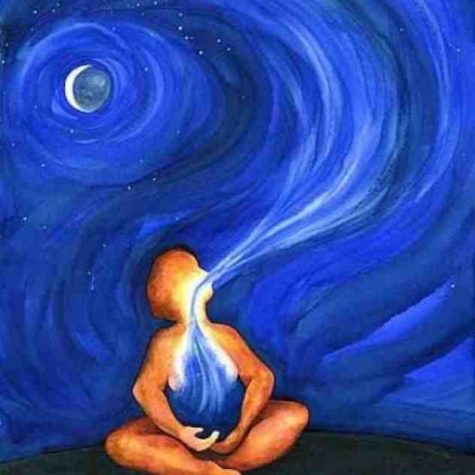Breath Work
With every breath we take, nature is potentially providing us with an opportunity of shifting our consciousness and entering an enlightened state. The reason this gateway to the greater reality remains firmly shut for most of us is that we don’t give it our attention. We are much more committed to following the commands of our inner commentator with its incessant stream of thoughts over which we have little control.
If we get into the habit of using our breath as a means of focusing attention away from our thoughts to our feelings, we would gradually obtain sovereignty over our mind and liberate ourselves from the compulsions and addictions of habitual and often idle thought. Above all, instead of debating good and bad, pros and cons in our thoughts, we open an instant highway to the spontaneous wisdom of the heart.
It is the decision making process more than anything else that will train our mind to embrace Stillness instead of continuing to endure the constant inner chatter and uncontrolled commentary of our thoughts. By deciding to favor our breathing with our attention, rather than our inner chatter, we are gradually training our minds to embrace a greater reality. From then on our thoughts will become our tools and instruments rather than our masters.
The best way to deprive our thoughts of their compulsive nutrition is by using a different mode of thinking and perception. Instead of seeing with your eyes which is then narrated and judged by our mind and our old ideas, we learn to see with your heart, without judgement or interpretation. Using the same process when speaking and hearing will make a difference to the quality of our communication.
This new mode of gathering information or communicating will connect us to a higher level of reality. It will also open the channels of intuition, which is basically a much more evolved form of thinking as it encompasses information we are consciously unaware of.
This new mode of operating our senses can be learned like any other skill. We will know when we are successful when our stream of thoughts becomes quiet and everything becomes still around us. Our thoughts are no longer in the driving seat and instead of continuous judgement, which takes all our energy and deprives us our objectivity, we become aware of a powerful feeling of compassion, love and connectedness to all life. Our ego identifications become less important as we begin to identify with the the space surrounding us rather than the voices in hour head. We access reality directly rather than our interpretation of it and gain a much more inclusive understanding of who we are.
The best way to practice this kind of Seeing and Thinking with our Heart is by connecting our feeling to our breathing. As we breathe constantly anyway, we can practice this technique all day long. Instead of following our thoughts we simply decide to follow our breathing. We do this breathing in the awareness of the energy and the stillness surrounding us through the base of our body.(see diagram) We then follow our breath as it reaches our heart. We then surrender our breath again to the Stillness of the greater consciousness surrounding us, the same space of consciousness where we have taken it from.
The surrender of our breath or outbreath is accompanied by a feeling of goodwill or love. With this feeling of love we also automatically surrender the idea of our limited ego identification without even thinking about it. Instead we take comfort in the fact that we offer everything we are to a greater reality and the much larger reality of our true being.
This is the Anytime Anywhere Meditation because we can do it anytime and anywhere, whilst washing, having breakfast, driving to work, in the office, at lunch, in the cinema, talking to friends or operating machinery because it is a feeling rather than a conscious thought process. We favor surrender rather than clinging to our thoughts and judgments. Gradually our thoughts will learn to follow the wisdom that rises from the heart rather than insist on its old prejudicial pattern. As our thinking becomes more clear and we become in tune with reality our actions will be guided by the rise of wisdom, and we will use our mind as an instrument.
Source: Multidimensional Man
There is no real translation for this mantra. It is concerned with energy, breath, and the placement of consciousness. It is one of the simplest and yet most powerful mantras for permanently altering your state of consciousness. It balances the masculine and feminine energies and focuses their combined force.
OM HUM
SO HUM
(While breathing in say, Om Huhm, and exhaling say, Soh Huhm)
Source: Tara May’s Blog
With one hand lightly on your heart, breathe easily and gently, feel the awareness of breath and heartbeat creating a clear, spacious place inside.
Breathe with the sound of the word bismillah (BiS-MiL-LaaH).
When we remember to connect our heart to the Heart of the Cosmos, we recall that, as the Sufis say, “God is your lover, not your jailer.”
~Neil Douglas-Klotz
From the space of stillness, something beautiful can flower. Life can be a song, a dance.. from that space of stillness… Where you become magnet of abundance at all levels.
How to attain that stillpoint? Concentrate the energy on the Hara, the point two inches below the navel.
That is the center from where one enters life and that is the center from where one dies and goes out of life. So that is the contact center between the body and the soul. If you feel a sort of wavering left and right and you don’t know where your center is, that simply shows that you are no longer in contact with your Hara, so you have to create that contact.
- When: In the night, when you go to sleep and first thing in the morning.
- Duration: 10 – 15 minutes.
Step 1: Locate the Hara
Lie down on the bed and put both your hands two inches below the navel and press a little.
Step 2: Take a Deep Breath!
Start breathing, deep breathing. You will feel that center coming up and down with the breathing. Feel your whole energy there as if you are shrinking and shrinking and shrinking and you are just existing there as a small center, very concentrated energy.
Step 3: Center While U Sleep!
Fall asleep doing it – that will be helpful. Then the whole night that centering persists. Again and again the unconscious goes and center is there. So the whole night without your knowing, you will be coming in many ways in deep contact with the center.
Step 4: Reconnect with the Hara
In the morning, the moment that you feel that sleep has gone, don’t open your eyes first. Again put your hands there, push a little, start breathing; again feel the Hara. Do this for 10 – 15 minutes and then get up.
Do this every night, every morning.
Within three months you will start feeling centered.
It is very essential to have a centering otherwise one feels fragmentary; then one is not together. One is just like a jigsaw – all fragments and not a whole. It is a bad shape, because without a center a man can drag but cannot love.
Without a center you can go on doing routine things in your life, but you can never be creative. You will live the minimum. The maximum will not be possible for you. Only by centering does one live at the maximum, at the zenith, at the peak, at the climax, and that is the only living, a real life. For example, there will be less thinking because energy will not move to the head, it will go to the Hara.
The more you think of the Hara, the more you concentrate there, the more you will find a discipline arising in you. That comes naturally, it has not to be forced. The more you are aware of the Hara, the less you will become afraid of life and death because that is the center of life and death.
Once you become attuned to the Hara center, you can live courageously. Courage arises out of it: less thinking, more silence, less uncontrolled moments,natural discipline, courage and rootedness, a groundedness.
Found at Inner Cosmos Meditation
Breath is life and change, a basic connection between the inner and the outer. It is a flowing bridge between life and death. Every breath is rebirth, inspiration, a letting go of the old. Breathing is a constant source of energy, a continuous affirmation.
Change your breathing and you will think differently, and this change can be created by choice because breathing is one of the few bodily functions that can be voluntary or automatic.
Here is an easy breathing exercise:
Fix your concentration in the middle of the forehead. See a radiant jewel there. Watch and observe what happens as you inhale through your nose – pulling your diaphragm in, and exhale through your nose – pushing your diaphragm out.
Repeat this process 6 or 10 times.
- What happened?
- How do you feel?
1. Sit on the forward third of a chair or a cushion on the floor.
2. Straighten and extend your spine, keeping it naturally upright, centering your balance in the lower abdomen. Push your lower back a little forward, open your chest, and tuck your chin in slightly, keeping the head upright, not leaning forward, or backwards, or to the side. Sway your body gently from left to right in decreasing arcs, until you naturally come to a point of stillness on your cushion.
3. Keep your eyes on the floor at a 45-degree angle, neither fully opened nor closed, and gaze naturally about 3 to 4 feet in front of your body. If the eyes are closed, you may want to start to daydream or visualize things. If your eyes are open wide open, your mind will scatter.
4. Keep your lips and teeth together with your tongue resting against the roof of your mouth.
5. Place your hands on your lap with the right palm up and your left hand (palm up) resting on your right hand, thumb tips lightly touching, forming a vertical oval. This is the mudra of zazen, in which all phenomena are unified. Rest this mudra with the blade of your hands against your abdomen, a few inches below the navel, harmonizing your own center of gravity with the mudra.
6. Take a deep breath, exhale fully, and then take another deep breath, exhaling fully. Let your breathe settle into its natural rhythm.
7. Keep your attention on your breath. When your attention wanders, bring it back to the breath again and again — as many times as necessary!
8.. Practice this Zen Meditation every day for at least ten to fifteen minutes (or longer).









